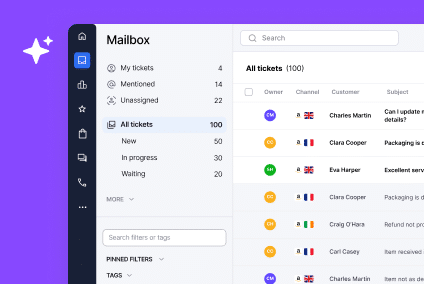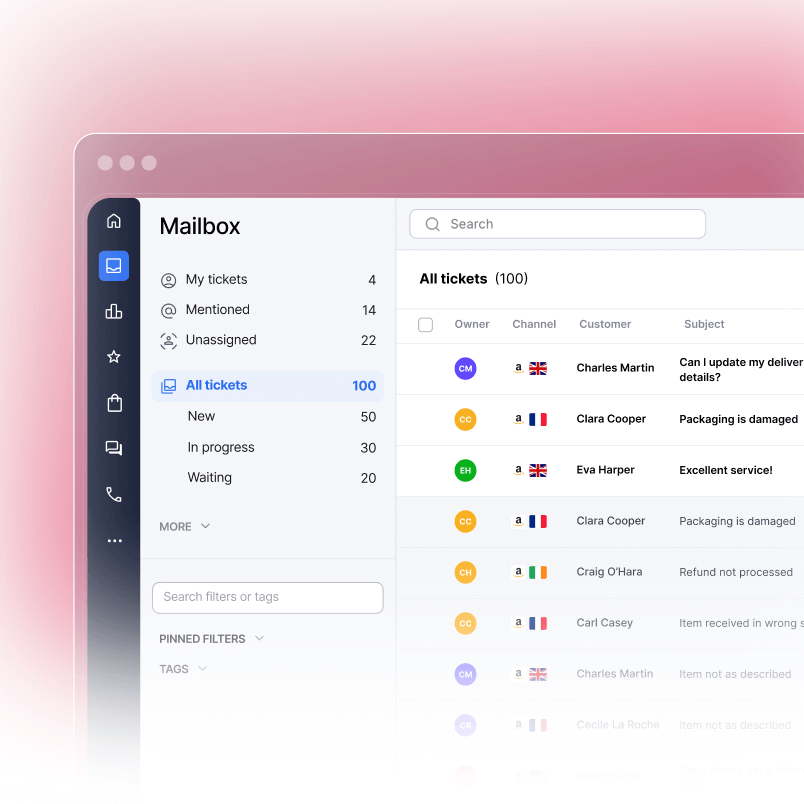Your customer service team isn’t just solving problems. They’re standing between you and abandoned carts, lost sales, and customers bouncing to your competitors.
Most ecommerce brands focus conversion optimization on landing pages and checkout flows. But the real conversion leverage sits in your support channels. When a shopper has a question about sizing, shipping costs, or your return policy right before clicking « Buy Now, » the quality and speed of your response determines whether they convert or leave.
This guide shows you exactly how to align customer service with conversion optimization. You’ll discover 18 tactical improvements across chat, email, and self-service that reduce friction, build trust, and turn inquiries into orders.
The Overlooked Link Between Customer Support and Conversion
Here’s the reality: 83% of online shoppers require assistance to complete a purchase. Yet most support strategies are built around fixing problems after the sale, not enabling sales before they happen.
Your support channels are conversion optimization tools. They reduce friction at the exact moment hesitation strikes. When a customer asks about your return policy via chat and receives an instant answer, they’re more likely to hit that purchase button. When your FAQ answers their sizing question before they even ask, you’ve removed a barrier to checkout.
The connection between support and conversion isn’t accidental. It’s structural. Every question left unanswered is a stalled transaction. Every response delayed is a shopper considering your competitor. Every vague reply is doubt creeping in.
The fastest growing ecommerce brands treat support-led conversion optimization as a strategic function, not a cost center. They embed support into every stage of the buyer journey, from product page exploration to post-purchase reassurance.
How Customer Service Shapes Purchase Decisions
Three forces drive purchase hesitation: trust gaps, information gaps, and urgency friction.
Support closes trust gaps by providing real-time human validation. When a shopper sees you have live agents available, they trust your brand more. When customer reviews appear in chat conversations, they see social proof instantly. When your return policy is clearly stated and easily accessible, they feel confident committing to the purchase.
Information gaps occur when shoppers need product details your page doesn’t explicitly cover. A buyer wondering if your shoes run small, your shipping timeline, or whether an item qualifies for free shipping doesn’t have time to search your site. They want an answer now. If support provides it instantly via chat, they convert. If they have to email you, they’ve likely already moved on.
Urgency friction happens in the final seconds before checkout. A shopper hesitates, thinking « What if I need to return this? » Your support message appears: « 45-day returns, free return shipping included. » Friction dissolves. Purchase completes.
The data backs this up. Brands that implement proactive support messaging on product pages see conversion rate lifts between 15% and 40%, depending on their industry and baseline conversion rate. Customers who engage with live chat convert at significantly higher average order values than those who don’t.
18 Customer Support Tactics to Boost Ecommerce Conversions
Live Chat and Pre-Sale Help
These tactics deploy support directly where buyers make decisions: on product pages and near checkout.
Trigger targeted chat popups on high-value product pages. Don’t show chat everywhere equally. Target your highest-margin or most-abandoned products first. If your luxury item has a 35% abandonment rate but your basics are steady, chat triggers on the luxury pages drive ROI faster.
Use chatbots to handle product questions and FAQ lookups. Train your bot to recognize common objections: « Does this ship free? » « What’s your return window? » « Is this in stock? » Bots answer in seconds, humans review and escalate complex conversations. This hybrid model answers 70% of pre-purchase questions instantly while keeping your team focused on high-value interactions.
Route high-value visitors to live agents strategically. Not all conversations are equal. If a shopper has added $500+ to their cart and now asks a question via chat, route that conversation to your best agent. That agent focuses on removing objections and closing the sale, not handling basic sizing questions.
Position a prominent « Chat with us » CTA next to your « Add to Cart » button. Most shoppers don’t know support is available. Make it obvious. Research shows placing a CTA button near checkout increases chat engagement by 25% and helps indecisive buyers pull the trigger.
Offer quick reply templates for common pre-purchase questions. Your team shouldn’t type full responses to « Do you ship to Canada? » every hour. Pre-written macros for sizing, shipping, returns, and stock inquiries cut response time to under 30 seconds and improve consistency. Customers perceive fast responses as a signal of reliable support, which signals a trustworthy brand.
Trust Building and Transparency
These tactics use support as a trust channel, not just a problem-solver.
Display real-time agent availability on product pages. A simple message like « Chat with us (avg response: 2 min) » converts better than « Chat with us » alone. Showing your team is online removes the fear of unanswered messages. Shoppers who see you’re online are 3x more likely to ask their question rather than abandon the cart.
Include verified customer reviews in chat macros and responses. When a customer asks about product quality, reply with a star rating and quote from verified buyers: « 95% of customers rate this 4.5 stars. One reviewer said: ‘Perfect fit and arrived in 3 days.' » This micro-social-proof moment converts hesitant shoppers into buyers.
Embed return policy links directly in chat responses and email templates. Shoppers worry about returns. Don’t make them search your site for the policy. Link it right in your response: « We offer 60-day returns. Here’s our full policy. » One click, doubt removed.
Reinforce your brand tone and empathy through every support interaction. Bland support messages feel corporate and cold. Your tone should match your brand voice. If you’re a playful brand, your chat responses should feel friendly. If you’re luxury, they should feel attentive and refined. Empathetic support increases perceived brand value and drives higher conversions.
Display trust badges alongside your support contact information. Show SSL certificates, security badges, money-back guarantees, and verified review badges near your chat widget and contact page. Seeing that you’re legitimate and secure removes final-moment doubt.
Email and Post-Support Follow-Up
These tactics use email to re-engage shoppers who’ve contacted you or abandoned their cart.
Send immediate support offers in your cart abandonment email sequences. Most abandonment emails focus on « Get 10% off. » Instead, include your support advantage: « Questions about your order? Chat with us or reply to this email. We typically respond in under 2 minutes. » Many shoppers abandon because they have an unanswered question, not because of price.
Link directly to live support in all abandoned cart reminder flows. If a shopper reads your first abandonment email and still has questions, make it frictionless to ask. A clickable « Chat now » button in the email beats a text instruction to visit your site and find chat.
Use smart email macros to add urgency when appropriate. If inventory is low on the product in their cart, add a line: « Stock running low on this item (only 3 left). Chat with us if you’d like to hold your order while you decide. » Scarcity + support access = faster decisions.
Self-Service Enhancements
These tactics reduce friction by helping shoppers find answers without waiting for support.
Improve searchability of your FAQ and help center. A poorly searchable FAQ is worse than no FAQ at all. It frustrates shoppers and drives them to support channels with preventable questions. Audit your FAQ structure. Make sure common questions use the language shoppers actually type into Google (e.g., « Do you ship to Alaska? » not « Which territories are excluded from our service area? »).
Embed FAQ widgets directly on product pages and cart pages. Don’t assume shoppers will visit your help center. Embed a collapsible FAQ widget on PDPs focused on that specific product. On your cart, embed FAQs about shipping and returns. Shoppers shouldn’t have to search.
Add order tracking tools to reduce post-purchase support tickets. Shoppers message support asking « Where’s my order? » when they can’t find tracking info. A real-time order tracking tool on your account page prevents these tickets entirely and reduces support volume by up to 15%, freeing your team for pre-sale conversations.
Pre-answer common objections in your chatbot logic. Train your bot to recognize skepticism: « How do I know this will fit? » The bot should respond with your sizing guide, fit guarantee, and verified customer reviews in one message. Many shoppers will convert without escalating to a human.
Highlight guarantees and free shipping in support prompts. If your brand offers free returns or a fit guarantee, these are conversion tools. Build them into your support messaging. When a customer hesitates, proactively mention: « Free returns for 45 days. No questions asked. » That safety net converts browsers into buyers.
How Support Impacts Key Conversion Metrics
Conversion Rate
Adding live chat software to a website usually boosts conversions by 20%. More compelling: chat users are 2.8 times more likely to convert than those who don’t engage. The uplift depends on your baseline conversion rate, product type, and team execution. The impact is measurable regardless of industry.
Cart Abandonment Rate
The average cart abandonment rate globally sits at 70.19%, translating to approximately $260 billion in recoverable lost orders annually. Support access reduces this rate by providing answers at the moment of hesitation. More than half of customers will abandon their shopping cart unless they get quick answers. Proactive messaging changes this dynamic.
Average Order Value
Customers who use live chat spend up to 60% more per purchase than those who don’t. Why? They’ve asked questions about products and received personalized guidance. They’ve built trust through conversation. Higher trust leads to bigger purchases.
Response Time Impact
89% of consumers say a quick response to an initial inquiry influences their purchase decision. The threshold matters: satisfaction peaks when initial response time falls within 5 to 10 seconds, with 84.7% customer satisfaction at this speed. Delays over 10 minutes often come too late; the shopper has already moved on.
Bounce Rate on Product Pages
When shoppers have quick access to support, bounce rates drop significantly. Customers who use live chat are 63% more likely to return to a website than those who don’t, indicating they feel valued and heard rather than abandoned.
Tools That Enable Support-Led Conversion Optimization
Live Chat and Automation
Live chat utilization results in a 48% surge in revenue per chat hour and a 40% increase in conversion rate, according to recent benchmarks. Implementing live chat properly means treating it as a revenue channel, not just a support tool. The platform should track which interactions lead to conversions so you understand ROI clearly.
AI Chatbots for Instant Responses
With present technology, chatbots are capable of resolving queries with up to 90% accuracy. Chatbots handle 60% to 70% of routine pre-purchase inquiries instantly. Train your bot to recognize common objections and route complex conversations to humans. 67% of customers across the world use chatbots for customer service, indicating this channel is now mainstream.
Email for Recovery and Follow-Up
Abandoned cart emails achieve an open rate of 39.07% and a click-through rate of 23.33%. More valuable: approximately 10% of shoppers who receive an abandonment email go on to complete purchase. Build sequences that link to live support so hesitant buyers can ask questions directly.
Analytics and Tracking
Use Google Analytics 4 and Hotjar to track user behavior by support channel. Create custom events that trigger when someone engages with chat before converting. Build reports showing conversion lift from chat interactions. This data justifies investment in your support team and guides resource allocation.
Aligning Your Support and CRO Teams
Support and conversion optimization often operate independently. Fixing that alignment multiplies results.
Set shared goals. Both teams should optimize for conversion rate, average order value, and customer satisfaction. When support is measured only on response time and satisfaction, they operate separately from CRO goals. Align metrics.
Review ticket themes weekly. Every support conversation reveals friction in your customer experience. Shoppers ask about sizing because your size guide is unclear. They ask about shipping because your policy isn’t prominent. Use this feedback to inform your CRO roadmap. Build this into weekly sprints.
Embed support feedback into CRO testing. Before running an A/B test on your product page, ask support: « What questions do shoppers ask about this product? » Design your test to answer those questions. Use their insights to guide copy changes, FAQ placement, and messaging.
Use support transcripts for copywriting. The language customers use in support conversations is the language you should use on your site. If shoppers always ask « How long does shipping take? », that’s the question your copy should answer before they ask. Use actual customer language to guide your pages.
Getting Started Today
You don’t need a massive overhaul to start capturing conversion from support. Begin with these three moves:
Week 1: Audit current support performance. Where are your customers getting stuck? Pull your top 20 support inquiries from the last month. What questions keep repeating? These are your biggest friction points and your biggest opportunities.
Week 2: Implement live chat on your top 3 products. Deploy a chat widget targeting your highest-margin or most-abandoned products. Add a simple auto-response: « Thanks for chatting with us. We typically respond in 2 minutes. » Measure engagement and conversion lift.
Week 3: Build your first support-to-email flow. Create an email sequence for shoppers who ask a pre-purchase question via chat but don’t convert within 24 hours. Send them the answer again plus a « Chat with us again » CTA. Track conversion lift.
After three weeks, you’ll have data. Use it to prioritize your next phase: expanding chat to more products, building more email flows, improving FAQ searchability, or implementing AI chatbots.
The brands winning at ecommerce aren’t just optimizing their product pages. They’re optimizing every conversation that influences a purchase decision. Your support team is your CRO team. They just don’t know it yet.
FAQs
Can customer support increase ecommerce conversions?
Yes. Support reduces friction at the exact moment hesitation strikes, turning questions into completed purchases. Live chat, proactive messaging, and quick responses all contribute to higher conversion rates and customer loyalty.
What’s the best support channel to reduce cart abandonment?
Live chat is fastest for stopping abandonment because it removes the waiting period. Shoppers get answers instantly, which removes their primary reason for abandoning. Email works for follow-up, but chat prevents abandonment in the first place by answering questions before they’re even fully formed.
How fast should I respond to convert a sale?
Response time under 2 minutes dramatically increases conversion probability. Anything under 5 minutes maintains reasonably high conversion rates. Responses over 10 minutes often come too late; the shopper has already moved on or visited a competitor. Speed signals to customers that you’re serious about helping them.
Which support tools impact conversion the most?
Live chat, AI chatbots, and order tracking tools have the highest direct impact on conversion metrics. Live chat removes friction in real-time. Chatbots handle routine questions instantly. Order tracking prevents post-purchase issues, freeing your team to focus on pre-sale conversations that drive conversions.
How do I measure the ROI of support-led conversion optimization?
Track three metrics: conversion rate of visitors who engage with chat versus those who don’t, average order value of chat engagers, and cart abandonment rate before and after implementing proactive support messaging. Compare these to your current baseline and multiply by average order value to calculate incremental revenue from support improvements.




